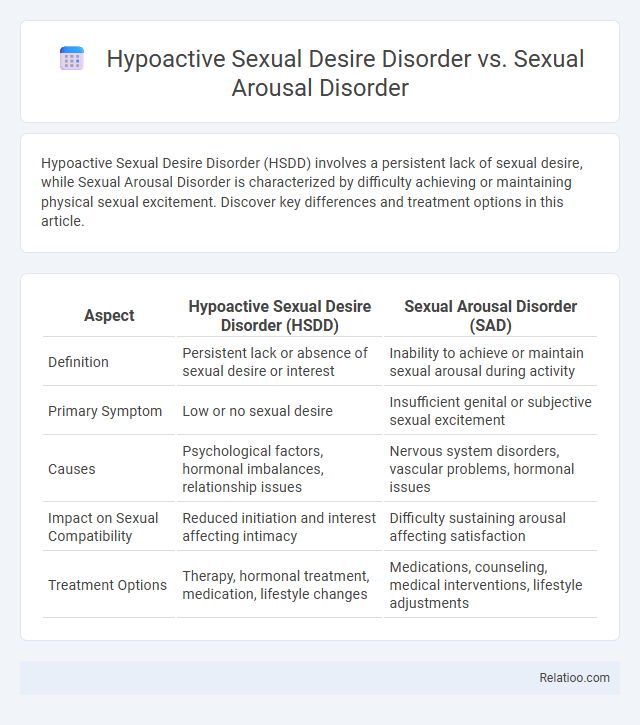Hypoactive Sexual Desire Disorder (HSDD) involves a persistent lack of sexual desire, while Sexual Arousal Disorder is characterized by difficulty achieving or maintaining physical sexual excitement. Discover key differences and treatment options in this article.
Table of Comparison
| Aspect | Hypoactive Sexual Desire Disorder (HSDD) | Sexual Arousal Disorder (SAD) |
|---|---|---|
| Definition | Persistent lack or absence of sexual desire or interest | Inability to achieve or maintain sexual arousal during activity |
| Primary Symptom | Low or no sexual desire | Insufficient genital or subjective sexual excitement |
| Causes | Psychological factors, hormonal imbalances, relationship issues | Nervous system disorders, vascular problems, hormonal issues |
| Impact on Sexual Compatibility | Reduced initiation and interest affecting intimacy | Difficulty sustaining arousal affecting satisfaction |
| Treatment Options | Therapy, hormonal treatment, medication, lifestyle changes | Medications, counseling, medical interventions, lifestyle adjustments |
Understanding Hypoactive Sexual Desire Disorder
Hypoactive Sexual Desire Disorder (HSDD) is characterized by a persistent or recurrent lack of sexual desire, which causes significant distress or interpersonal difficulty. Unlike Sexual Arousal Disorder, which primarily involves difficulties in achieving or maintaining physical sexual arousal, HSDD focuses on the psychological absence of sexual interest or fantasies. Understanding HSDD requires recognizing its impact on emotional well-being and relationships, differentiating it from arousal disorders that are more physiological in nature.
Defining Sexual Arousal Disorder
Sexual Arousal Disorder is defined by the consistent inability to attain or maintain adequate sexual excitement, often marked by insufficient genital or non-genital response during sexual activity. Hypoactive Sexual Desire Disorder involves a low or absent sexual desire, whereas Arousal Disorder generally refers to difficulties in becoming physically aroused despite sexual desire. Understanding the specific challenges in arousal can help you seek targeted treatment to improve sexual function and satisfaction.
Key Differences Between Desire and Arousal Disorders
Hypoactive Sexual Desire Disorder (HSDD) is characterized by a persistent lack of sexual thoughts, fantasies, or desire, whereas Sexual Arousal Disorder primarily involves difficulty achieving or maintaining physiological sexual excitement despite normal desire. Arousal disorder can refer broadly to problems with sexual response but differs from HSDD as it centers on physical sexual readiness rather than the psychological aspect of desire. The key difference lies in desire disorders affecting interest levels and motivation for sexual activity, while arousal disorders impact bodily sexual responses.
Common Symptoms of HSDD
Hypoactive Sexual Desire Disorder (HSDD) primarily manifests as a persistent lack or absence of sexual thoughts, fantasies, and desire, distinguishing it from Sexual Arousal Disorder, which involves difficulties achieving or maintaining physical sexual excitement. Common symptoms of HSDD include reduced spontaneous sexual interest, diminished responsiveness to sexual cues, and distress over decreased libido. Unlike general Arousal Disorders that concern physiological responses, HSDD is specifically characterized by psychological and emotional deficits in sexual desire.
Symptoms Indicative of Sexual Arousal Disorder
Symptoms indicative of Sexual Arousal Disorder include difficulty achieving or maintaining an adequate lubrication-swelling response during sexual activity, resulting in discomfort or inability to continue. Unlike Hypoactive Sexual Desire Disorder, which primarily involves a lack of sexual desire, Sexual Arousal Disorder specifically affects physical arousal mechanisms. Recognizing these symptoms helps your healthcare provider differentiate Arousal Disorder from other sexual dysfunctions for targeted treatment.
Causes and Risk Factors for Each Disorder
Hypoactive Sexual Desire Disorder (HSDD) is primarily caused by hormonal imbalances, psychological factors such as depression or anxiety, and relationship issues. Sexual Arousal Disorder often results from vascular problems, neurological conditions, or medication side effects that impair genital blood flow and sensitivity. Arousal disorder encompasses both psychological influences, including stress and trauma, and physical conditions like diabetes or hormonal deficiencies that disrupt sexual response mechanisms.
Diagnosis: Distinguishing HSDD from Arousal Disorders
Hypoactive Sexual Desire Disorder (HSDD) is primarily diagnosed by a persistent lack of sexual desire causing distress, while Sexual Arousal Disorder involves difficulty achieving or maintaining physiological sexual excitement. Distinguishing HSDD from Arousal Disorders requires careful assessment of symptoms, as HSDD centers on desire whereas arousal disorders focus on physical response. Your healthcare provider may use detailed patient history, validated questionnaires, and sometimes hormonal evaluations to accurately differentiate these conditions for effective treatment planning.
Treatment Options for Hypoactive Sexual Desire Disorder
Treatment options for Hypoactive Sexual Desire Disorder (HSDD) include hormone therapy such as testosterone supplementation, psychological counseling, and the use of FDA-approved medications like flibanserin and bremelanotide. In contrast, Sexual Arousal Disorder often requires therapies targeting vascular or neurological causes, including topical estrogen or lubricants, while Arousal Disorder encompasses a broader category of dysfunctions needing individualized treatment approaches. Addressing HSDD effectively combines pharmacological interventions with cognitive-behavioral therapy to enhance desire and improve overall sexual satisfaction.
Approaches to Managing Sexual Arousal Disorder
Sexual Arousal Disorder management typically involves a multidisciplinary approach combining psychotherapy, pharmacotherapy, and lifestyle modifications tailored to individual needs. Cognitive-behavioral therapy (CBT) and sensate focus techniques address psychological barriers, while pharmacological treatments may include testosterone therapy or PDE5 inhibitors to enhance physiological arousal. Emphasizing open communication between partners and addressing underlying medical conditions further optimizes therapeutic outcomes.
Supporting Individuals with Sexual Dysfunction
Supporting individuals with Hypoactive Sexual Desire Disorder (HSDD) involves addressing persistent low sexual desire that causes distress, often through tailored psychosexual therapy and medical interventions like hormonal treatments. Sexual Arousal Disorder requires focused strategies to improve physiological response, including pelvic floor exercises and targeted pharmacotherapy to enhance genital blood flow. Effective management of Arousal Disorder encompasses multidisciplinary approaches combining psychological counseling, lifestyle modifications, and specialized medical treatments to restore sexual function and improve quality of life.

Infographic: Hypoactive Sexual Desire Disorder vs Sexual Arousal Disorder
 relatioo.com
relatioo.com